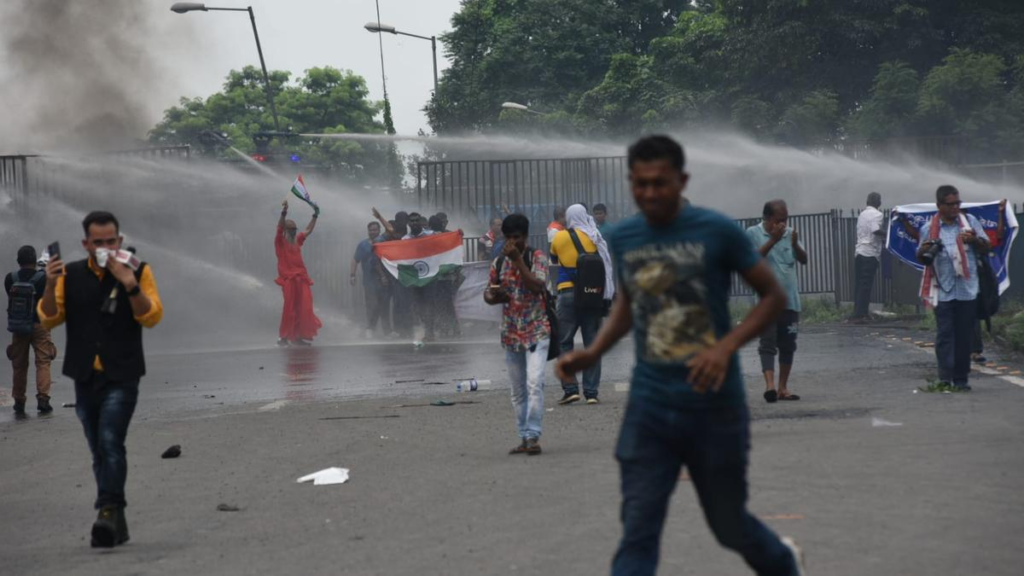Introduction
On August 27, 2024, Kolkata witnessed a dramatic escalation in tensions as the ‘Nabanna Abhijan’ rally, organized to protest the brutal rape and murder of a trainee doctor at RG Kar Medical College and Hospital, turned violent. The city’s streets became the epicenter of a heated clash between protesters and law enforcement, leading to significant disruptions and widespread condemnation.

Protesters Break Police Barricades and Clash with Authorities
The ‘Nabanna Abhijan’ protest march, initiated by various students’ organizations, aimed to march towards the West Bengal State Secretariat to voice grievances over the RG Kar incident. As the rally advanced, protesters forcefully broke through police barricades, stomping on them and chanting slogans. The situation grew more intense as they clashed with police officers stationed at strategic points along the route.
Police Response: Water Cannons, Tear Gas, and Lathi Charges
In response to the escalating violence, the Kolkata Police employed water cannons, tear gas, and lathicharges to disperse the crowd. The confrontation reached its peak at Howrah Bridge, where protesters attempted to breach barricades set up by authorities. The aggressive tactics by the police were met with strong criticism from various quarters, including political leaders and human rights activists.
BJP Accuses Police of Brutal Repression
Suvendu Adhikari, the Leader of the Opposition in the West Bengal Assembly, condemned the police’s actions as “brutal repression” against what he described as “peaceful protesters.” He accused the authorities of using excessive force, including water cannons and tear gas, to suppress the demonstrators. Adhikari warned that if the repression continued, the BJP would take further action, including a statewide shutdown.
Timeline of Events
August 27, 2024:
- 6:54 AM: The CBI concludes its second round of polygraph tests on former RG Kar hospital principal Sandip Ghosh and accused Sanjoy Roy.
- 8:14 AM: Educational institutions close or shift classes online due to the anticipated disruption caused by the Nabanna Abhijan rally.
- 8:39 AM: Kolkata Police implement road closures for goods traffic to manage the impact of the rally.
- 9:15 AM: Union Minister Sakunta Majumdar visits the victim’s family and lights a candle in memory of the trainee doctor.
- 9:54 AM: BJP leader Dilip Ghosh criticizes the police for labeling the protest as illegal.
- 10:14 AM: West Bengal Governor CV Ananda Bose urges the government to permit the rally to proceed peacefully, invoking Supreme Court directives.
- 10:59 AM: The Kolkata Police issues a traffic advisory to manage the flow of vehicles amidst the ongoing rally.
- 11:26 AM: The ruling Trinamool Congress labels the rally as illegal, accusing it of inciting unrest.
- 11:50 AM: Police take preventive measures, including oiling barricades to prevent protesters from climbing over them.
- 12:05 PM: The CBI examines the house and documents of RG Kar hospital’s medical superintendent, Saptarshi Chatterjee.
- 12:51 PM: Over 6,000 police personnel are deployed, and a three-layer security system is established outside Nabanna.
- 1:07 PM: Protesters drag away barricades and engage in confrontations with the police, leading to lathi charges and tear gas use.
- 1:42 PM: The police escalate their response with water cannons and tear gas on Howrah Bridge.
- 2:04 PM: Police detain protesters from Howrah Bridge and use tear gas and water cannons to control the situation.
- 2:15 PM: Suvendu Adhikari warns of a statewide shutdown if police repression does not cease.
- 2:32 PM: Adhikari continues to criticize the police for their heavy-handed tactics against what he claims were peaceful protesters.
- 2:43 PM: Protesters break barricades, leading to increased violence and clashes with security forces.
Expert’s Opinions
Dr. Arvind Kumar, a political analyst, stated, “The police response was disproportionately aggressive. In a democratic society, such measures should be a last resort, and it’s critical to evaluate whether the force used was justified.”
Ms. Priya Chatterjee, a human rights advocate, remarked, “The violence witnessed today raises serious concerns about the state’s handling of peaceful protests. Ensuring the right to protest without unnecessary suppression is fundamental to democratic principles.”
Conclusion
The ‘Nabanna Abhijan’ rally in Kolkata has underscored significant tensions surrounding the RG Kar Medical College and Hospital rape-murder case. With protesters clashing with police and allegations of excessive force, the situation remains volatile. The response from authorities and political leaders will likely shape the ongoing discourse on civil liberties and state power in West Bengal.
For Regular News and Updates Follow – Sentinel eGazette
External Sources and References:
- Hindustan Times – Kolkata Doctor Rape-Murder Case
- ABP Bengal – Police Actions and Protest Details
- The Indian Express – Timeline of Events
FAQs
Q1: What is the main reason behind the ‘Nabanna Abhijan’ rally?
- The ‘Nabanna Abhijan’ rally was organized to protest against the brutal rape and murder of a trainee doctor at RG Kar Medical College and Hospital, demanding justice for the victim.
Q2: How did the Kolkata Police respond to the protesters?
- The Kolkata Police responded with water cannons, tear gas, and lathicharges to disperse the protesters, especially when they attempted to breach barricades and engage in violent confrontations.
Q3: Who are the key political figures involved in the controversy?
- Key figures include Suvendu Adhikari, Leader of the Opposition, who criticized the police for their handling of the protest, and Sakunta Majumdar, who visited the victim’s family and supported the rally.
Q4: What were the consequences of the clash between protesters and the police?
- The clash resulted in significant disruptions, detentions of protesters, and increased tensions between political parties and law enforcement.
Q5: What measures were taken by the authorities to manage the rally’s impact?
- Authorities implemented road closures, deployed over 6,000 police personnel, and established a three-layer security system to manage the rally’s impact and prevent further escalation.